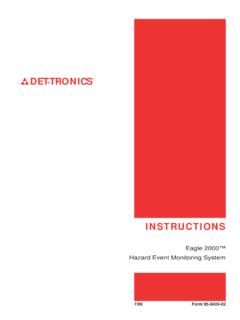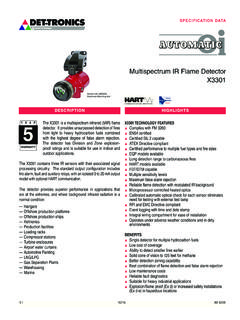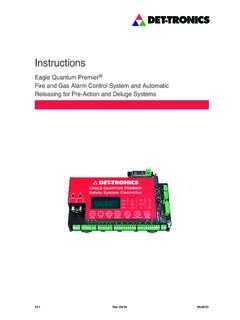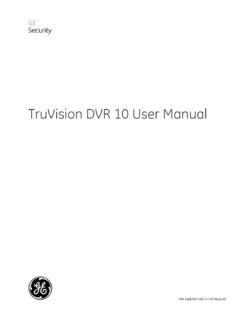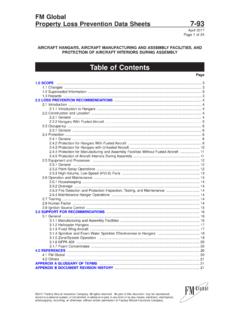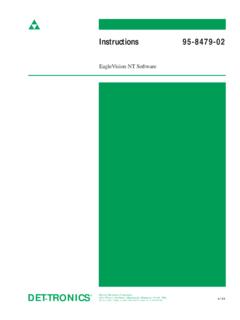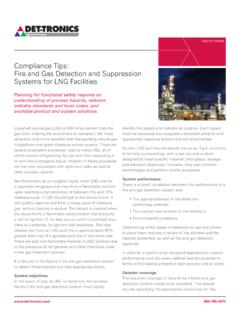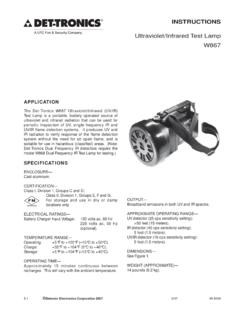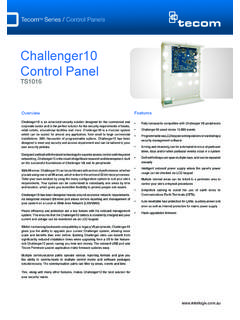Transcription of INSTRUCTIONS - Det-Tronics
1 INSTRUCTIONSU ltraviolet Flame Detection SystemR7404 ControllerC7050 Detector7/97 Form 95-8242-04To navigate throughthis document, clickon the Bookmarksand Page button and use thebookmarks to of ContentsSYSTEM APPLICATION ..1 FEATURES ..2 GENERAL APPLICATION INFORMATION ..2 SYSTEM DESCRIPTION ..2 Detector ..3 controller ..3 SPECIFICATIONS ..5 DETECTOR SENSITIVITY ..6 SYSTEM SENSITIVITY CONSIDERATIONS ..8 INSTALLATION ..10 Wiring Requirements ..10 Detector Positioning and Density ..11 Mounting the Detector ..11 controller ..13 TYPICAL SYSTEM APPLICATIONS ..17 STARTUP PROCEDURE ..21 CHECKOUT PROCEDURE ..21 Manual oiCheck ..21 Detector Count Test ..21 Manual Check in Normal Mode ..22 MAINTENANCE ..23 TROUBLESHOOTING ..23 DEVICE REPAIR AND RETURN ..23 ORDERING INFORMATION ..25 Options ..26 Recommended Spare Parts ..26 SYSTEM APPLICATIONThe Det-Tronics model R7404 controller and C7050 Detector provide fast, reliable flame detection in a widevariety of applications.
2 The microprocessor based con-troller simultaneously monitors up to 16 C7050 ultraviolet(UV) detectors in up to 8 different zones. The systemuses the Automatic Optical Integrity (oi) feature, whichprovides a continuous check of detector optical sur-faces, detector sensitivity, and electronic circuitry of thedetector/ controller system. Also included is automaticfault identification, which monitors the system for properoperation, and provides a digital display of system sta-tus using a numerical code. Other features include indi-vidual zone identification and voting capability, as wellas manual C7050 Detector responds instantly to the ultravioletradiation that is emitted by a flame. It is designed foruse in hazardous locations and is particularly suitable foruse in outdoor applications because it is not affected bywind or rain, and is insensitive to solar radiation.
3 In addi-tion, the detector does not respond to normal applications for Det-Tronics UV detection sys-tems are: Wherever highly combustible materials are involved Where there is a need for instantaneous response toflame Wherever unsupervised areas require automated fireprotection Where there is a large capital investment to be of actual installations using the Det-Tronics UVdetector in automated fire protection systems include:Petroleum Products Gasoline transport loading terminals Offshore drilling and production platforms Pipeline pumping stations Tank farms Refineries Marine engine rooms Jet engine test cellsGaseous Fuels Butane and propane loading and storage Pipeline compressor stations Gas gathering facilities Pipelines in highly populated areas LNG loading, transfer and storage facilities Hydrogen and ammonia production and refineryreformers Gas turbinesINSTRUCTIONS Detector Electronics Corporation 199707/9795-8242-04*oiis Detector Electronics' Trademark for its patented OpticalIntegrity Systems, Patent 3,952,196, United Kingdom Patent1,534,969, Canada Patent 1,059, Flame Detection SystemR7404 ControllerC7050 DetectorSolid Materials Munitions production such as illuminating flare materi-al, TNT.
4 And other propellants Powder coating boothsOther Processes Paint Spray booths Chemical and Petrochemical productionInformation on these and a wide variety of applications isavailable from Detector Instantaneous response to ultraviolet radiation. Detectors operate under adverse weather conditionssuch as wind, rain, snow, high humidity, and extremesof temperature or pressure. Automatic Optical Integrity. Adjustable sensitivity and time delay. All automatic test functions performed with the systemon line. Manual oitest capability (in addition to Automatic oicapability). Automatic fault identification. Individual zone identification with eight voting options. Microprocessor control. Latching ZONE LEDs identify the zone responding tofire. Output circuits can be made latching or non-latchingthrough field adjustment.
5 Individual detector output (count rate) can be mea-sured and observed on the digital display. Digital display of background UV signals in Test mode. Digital display signal output available at field wiringterminals for interfacing with computers or other equip-ment. Detector is Factory Mutual (FM) approved, CanadianStandards Association (CSA) certified, andBASEEFA/CENELEC APPLICATION INFORMATIONIn applying any type of sensing device as a fire detector,it is important to know of any conditions that may preventthe device from responding to a fire, and also to knowwhat other sources besides fire will cause the device torespond. A UV detector is useful in fire protection appli-cations because it will provide very fast response to thepresence of ultraviolet radiation emitted by a flame.
6 Inaddition, it is not affected by environmental conditionssuch as wind, rain, or extremes of temperature and pres-sure. The Det-Tronics UV system is also insensitive tothe ultraviolet component of solar the above, it can be seen that there are firedetection applications where only ultraviolet sensors aresuitable. However, success in using an ultraviolet detec-tor is dependent not only on knowing its advantages, butalso its limitations. It is important to note that electric arcwelding is a source of intense ultraviolet radiation, andcare must be taken to ensure that arc welding is not per-formed in protected areas without securing the addition, UV detectors should not be positioned sothat their cone of vision can scan the horizon. Rather,they should be directed down over the designated haz-ardous area to reduce the likelihood of picking up UVradiation from distant important fact regarding radiation detectors of anytype is that the radiation must reach the detectors inorder for them to respond.
7 Care must be taken to keepobstructions out of the line of view. For an ultravioletdetector, this means that ultraviolet absorbing gases orvapors as well as physical obstructions must not beallowed to come between the detector and the protectedhazard. Smoke will absorb ultraviolet radiation, and ifaccumulations of dense smoke can be expected to pre-cede the presence of flame, then UV detectors that areused in enclosed areas should be mounted on the wallapproximately 3 feet (1 meter) from the ceiling where theaccumulation of smoke is reduced. Glass and plexi-glass windows also significantly attenuate UV radiationand must not be located between the detector and apotential flame source. If the window cannot be eliminat-ed or the detector location changed, contact DetectorElectronics for recommendations regarding windowmaterials that will not attenuate UV must be noted that malfunctions can occur in any typeof equipment, and although Det-Tronics systems aresubjected to rigorous tests before shipment, no way hasyet been found to guarantee that every device willalways operate perfectly.
8 The highest reliability withregard to response to a fire is achieved when a haz-ardous area is supervised by more than one detector,and when each detector can independently register DESCRIPTIONThe R7404/C7050 UV detection system consists of anR7404 controller and up to 16 C7050 C7050 Detector responds to UV radiation over therange of 1850 to 2450 angstroms. It is insensitive todirect or reflected sunlight and to normal artificial output of the detector consists of a series of voltagepulses or counts. The frequency of these pulses isdirectly proportional to the intensity of the radiation beingdetected and is measured in counts per second (cps).oiThe detector is equipped with the Automatic oifeature(Figure 1). A UV test lamp is mounted in the sameenclosure with the UV sensor tube, but they are opticallyisolated from each other by a cylindrical shield.
9 Whenthe test lamp is actuated by a signal from the controller ,it generates a UV test signal that travels out through theviewing window, where it encounters the reflective oiring and is directed back through the window to the sen-sor. The controller evaluates the strength of the returnsignal to determine the relative condition of the detectorand its optical surfaces. Since this UV test signal mustpass through the same portion of the viewing window asUV radiation generated by a flame, a reliable test of theability of the detector to see a fire is controller continuously executes the automatic oitest, sequentially testing each detector connected to a fault should occur in the system, it is quickly detect-ed and registered on the digital display on the frontpanel of the controller and the Fault output is ReflectionoiThe use of an Internal Reflection oidetector is recom-mended in applications where corrosive or oily contami-nants are present in the atmosphere.
10 This type of envi-ronment can cause rapid deterioration of the reflectivityof externally mounted oirings, resulting in the need forfrequent detector maintenance. Since the InternalReflection detector checks the cleanliness of the viewingwindow without the use of an external reflective oiring,faults caused by corrosion or contamination of the ringare eliminated. A fault will be indicated only if the view-ing window is actually dirty. It is important to note thatthe internal reflection system is effective only with oilysubstances that wet the surface of the window. It doesnot detect dry contaminants and, therefore, is not practi-cal for powder coating booths or similar applicationswhere various dry contaminants can obscure the visionof the detectors that are currently using the external reflec-tion oisystem can easily be converted to InternalReflection in the field by simply replacing the existingsensor tube module with a DE1888V Internal ReflectionoiTube Module.
